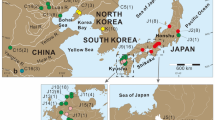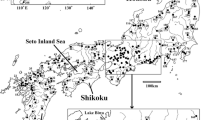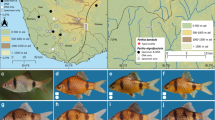Abstract
To investigate the influence of the Kuroshio Current on the high diversity of marine fishes in Japanese waters, the intraspecific phylogeographic structure of Blacktip Grouper, Epinephelus fasciatus, was determined. The genetic analysis of E. fasciatus indicated three intraspecific mtDNA lineages representing different evolutionary histories: the first lineage differentiated in Japanese waters during a long period of fluctuations of the ancient Kuroshio Current, the second lineage, widely distributed in the tropical western Pacific, was transported to Japanese waters by the Kuroshio Current and the third lineage was distributed primarily around the Ogasawara (Bonin) Islands. Present-day sympatric distributions of the three lineages, characterized by different ratios of such individuals at each geographic site, indicated a complex genetic pattern that was classified into three demographic groups, the dispersal and gene flows of which were strongly influenced by the Kuroshio Current and factors such as countercurrent and island arc. Genetic breaks in E. fasciatus populations were congruent with other fish faunal boundaries in Japanese waters.







Similar content being viewed by others
References
Akaike H (1973) Information theory and an extension of the maximum likelihood principle. In: Petrov BN, Csaki F (eds) Second international symposium on information theory. Akademiai Kiado, Budapest, Hungary, pp 267–281
Almany GR, Berumen ML, Thorrold SR, Planes S, Jones GP (2007) Local replenishment of coral reef fish populations in a marine reserve. Science 316:742–744
Avise JC (2000) The history and purview of phylogeography. In: Avise JC (ed) Phylogeography: The history and formation of species. Harvard University Press, Cambridge, pp 3–36
Bernardi G, Findley L, Rocha-Olivares A (2003) Vicariance and dispersal across Baja California in disjunct marine fish populations. Evolution 57:1599–1609
Bowen BW, Bass AL, Mus A, Carlin J, Robertson DR (2006a) Phylogeography of two Atlantic squirrelfishes (Family Holocentridae): exploring links between pelagic larval duration and population connectivity. Mar Biol 149:899–913
Bowen BW, Muss A, Rocha LA, Grant WS (2006b) Shallow mtDNA coalescence in Atlantic pygmy angelfishes (Genus Centropyge) indicates a recent invasion from the Indian Ocean. J Hered 97:1–12
Briggs JC (1974) Chapter 8: Northern Hemisphere Warm-Temperate Regions, and Chapter 9: Northern Hemisphere Cold-Temperate Regions. In: Briggs JC (ed) Marine Zoogeography. McGraw-Hill, Inc., New York, pp 196–245, 247–297
Castelloe J, Templeton A (1994) Root probabilities for intraspecific gene trees under neutral coalescent theory. Mol Phylogenet Evol 3:102–113
Clement M, Posada D, Crandall KA (2000) TCS: A computer program to estimate gene genealogies. Mol Ecol 9:1657–1659
Craig MT, Hastings PA (2007) A molecular phylogeny of the groupers of the subfamily Epinephelinae (Serranidae) with a revised classification of the Epinephelini. Ichthyol Res 54:1–17
Drummond AJ, Rambaut A (2007) BEAST: Bayesian evolutionary analysis by sampling trees. BMC Evol Biol 7:214
Drummond AJ, Rambaut A, Shapiro B, Pybus OG (2005) Bayesian coalescent inference of past population dynamics from molecular sequences. Mol Biol Evol 22:1185–1192
Dupanloup I, Schneider S, Excoffier L (2002) A simulated annealing approach to define the genetic structure of populations. Mol Ecol 11:2571–2581
Eble JA, Toonen RJ, Bowen BW (2009) Endemism and dispersal: comparative phylogeography of three surgeonfishes across the Hawaiian Archipelago. Mar Biol 156:689–698
Excoffier L (2004) Patterns of DNA sequence diversity and genetic structure after a range expansion: lessons from the infinite-island model. Mol Ecol, 13:853–864
Excoffier L, Laval G, Schneider S (2005) ARLEQUIN ver. 3.0: an integrated software package for population genetics data analysis. Evol Bioinform Online 1:47–50
Excoffier L, Smouse PE, Quatro JM (1992) Analysis of molecular variance inferred from metric distances among DNA haplotypes: application to human mitochondrial DNA restriction data. Genetics 131:479–491
Fu YX (1997) Statistical neutrality of mutations against population growth, hitchhiking and background selection. Genetics 147:915–925
Fujikura K, Lindsay D, Kitazato H, Nishida S, Shirayama Y (2010) Marine biodiversity in Japanese waters. PLoS One 5(8):e11836
Goloboff PA, Farris JS, Nixon KC (2008) TNT, a free program for phylogenetic analysis. Cladistics 24:774–786
Grant WS, Bowen BW (1998) Shallow population histories in deep evolutionary lineages of marine fishes: insights from sardines and anchovies and lessons for conservation. J Hered 89:415–426
Hasegawa M, Kishino H, Yano T (1985) Dating of the human-ape splitting by a molecular clock of mitochondrial DNA. J Mol Evol 22:160–174
Herpending HC (1994) Signature of ancient population growth in a low resolution mitochondrial DNA mismatch distribution. Hum Biol 66:591–600
Hickey AJ, Lavery SD, Hannan DA, Scott-Baker C, Clements KD (2009) New Zealand triplefin fishes (family Tripterygiidae): contrasting population structure and mtDNA diversity within a marine species flock. Mol Ecol 18:680–696
Jobb G, von Haeseler A, Strimmer K (2004) Treefinder: a powerful graphical analysis environment for molecular phylogenetics. BMC Evol Biol 4:18
Jobb G (2008) TREEFINDER Version October 2008. http://www.treefinder.de/. Accessed August 2010
Jones GP, Milicich MJ, Emslie MJ, Lunow C (1999) Self-recruitment in a coral reef fish population. Nature 402:802–803
Jordan DS (1901) The fish fauna of Japan, with observation on the geographical distribution of fishes. Science, new series vol XIV 354:545–567
Kawabe K (2005) Embryonic development and effect of water temperature on hatching of the Blacktip Grouper, Epinephelus fasciatus. Aquaculture Sci 53:333–342
Kawabe K, Kato K, Kimura J (2000) Year round spawning of reared blacktip grouper, Epinephelus fasciatus, in Chichi-jima, Ogasawara Islands, southern Japan. Aquaculture Sci 48:467–473
Kawabe K, Kato K, Kimura J, Saito M, Ando K, Kakiuchi K (1997) Growth of reared blacktip grouper Epinephelus fasciatus in Chichijima, Ogasawara Islands, Southern Japan. Aquaculture Sci 45:207–212
Kawabe K, Kohno H (2009) Morphological development of larva and juvenile blacktip grouper, Epinephelus fasciatus. Fish Sci 75:1239–1251
Kimura M (2000) Paleogeography of the Ryukyu Islands. Tropics 10:5–24
Kimura M (1980) A simple method for estimating evolutionary rates of base substitutions through comparative studies of nucleotide sequences. J Mol Evol 16:111–120
Kimura M, Weiss GH (1964) The stepping stone model of population structure and the decrease of genetic correlation with distance. Genetics 49:561–576
Kuriiwa K, Hanzawa N, Yoshino T, Kimura S, Nishida M (2007) Phylogenetic relationships and natural hybridization in rabbitfishes (Teleostei: Siganidae) inferred from mitochondrial and nuclear DNA analyses. Mol Phylogenet Evol 45:69–80
Liu JX, Gao TX, Wu SF, Zhang YP, (2007) Pleistocene isolation in the Northwestern Pacific marginal seas and limited dispersal in a marine fish, Chelon haematocheilus (Temminck and Schlegel, 1845). Mol Ecol 16:275–288
Matsuura K, Senou H (2012) Introduction of Fishes in the Kuroshio Current. In: Matsuura K (ed) Fishes in the Kuroshio Current. Tokai University Press, Kanagawa, pp 3–16
Nakabo T (2002) Characteristics of the fish fauna of Japan and adjacent waters. In: Nakabo T (ed) Fishes of Japan with pictorial keys to the species, English edition. Tokai University Press, Tokyo, pp xliii–lii
Nishimura S (1992) General Remarks. In: Nishimura S (ed) Guide to seashore animals of Japan with color pictures and keys, vol. 1. Hoikusha, Osaka, pp xi–xix
Ota H (1998) Geographic patterns of endemism and speciation in amphibians and reptiles of the Ryukyu Archipelago, Japan, with special reference to their paleogeographical implications. Res Popul Ecol 40:189–204
Palumbi SR (1994) Genetic divergence, reproductive isolation, and marine speciation. Ann Rev Ecol Syst 25:547–572
Rambaut A, Drummond A (2009) TRACER v1.5. http://tree.bio.ed.ac.uk/software/tracer/. Accessed January 2013
Randall JE, Heemstra PC (1991) Revision of Indo-Pacific groupers (Perciformes: Serranidae: Epinephelinae), with descriptions of five new species. Indo-Pacific Fishes No. 20. Bishop Museum, Honolulu, Hawaii
Randall JE, Ida H, Kato K, Pyle RL, Earle JL (1997) Annotated checklist of the inshore fishes of the Ogasawara Islands. Natn Sci Mus Monographs, No. 11. National Science Museum, Tokyo
Rice WR (1989) Analyzing tables of statistical test. Evolution 43:223–225
Riginos C, Nachman MW (2001) Population subdivision in marine environments: the contributions of biogeography, geographical distance and discontinuous habitat to genetic differentiation in a blennioid fish, Axoclinus nigricaudus. Mol Ecol 10:1439–1453
Rocha LA, Bass AL, Robertson R, Bowen BW (2002) Adult habitat preferences, larval dispersal, and the comparative phylogeography of three Atlantic surgeonfishes (Teleostei: Acanthuridae). Mol Ecol 11:243–252
Rocha LA, Rocha CR, Robertson DR, Bowen BW (2008) Comparative phylogeography of Atlantic reef fishes indicates both origin and accumulation of diversity in the Caribbean. BMC Evol Biol 8:157
Rogers AR (1995) Genetic evidence for a Pliocene population explosion. Evolution 49:608–615
Rogers AR, Harpending H (1992) Population growth makes waves in the distribution of pairwise genetic differences. Mol Biol Evol 9:552–569
Ronquist F, Teslenko M, Van Der Mark P, Ayres DL, Darling A, Höhna S, Larget B, Liu L, Suchard MA, Huelsenbeck JP (2012) MrBayes 3.2: Efficient Bayesian phylogenetic inference and model choice across a large model space. Syst Biol 61:539–542
Schneider S, Excoffier L (1999) Estimation of past demographic parameters from the distribution of pairwise differences when the mutation rates vary among sites: application to human mitochondrial DNA. Genetics 152:1079–1089
Senou H (2002) Family Serranidae. In: Nakabo T (ed) Fishes of Japan with pictorial keys to the species, English edition. Tokai University Press, Tokyo, pp 690–731
Senou H, Shinohara G, Matsuura K, Furuse K, Kato S, Kikuchi T (2002) Fishes of Hachijo-jima Island, Izu Islands Group, Tokyo, Japan. Mem Nat Sci Mus Tokyo 38:195–237
Senou H, Morita Y, Morishita O (2003) Notes on the distribution of a surgeonfish Ctenochaetus hawaiiensis (Perciformes: Acanthuridae). I.O.P. Diving News 14(10):2–4
Senou H, Matsuura K, Shinohara G (2006) Checklist of fishes in the Sagami Sea with zoogeographical comments on shallow water fishes occurring along the coastlines under the influence of the Kuroshio Current. Mem Nat Sci Mus Tokyo 41:389–542
Shimada K (2002) Family Chaetodontidae. In: Nakabo T (ed) Fishes of Japan with pictorial keys to the species, English edition. Tokai University Press, Tokyo, pp 884–897
Shirai S, Kuranaga R, Sugiyama H, Higuchi M (2006) Population structure of the sailfin sandfish, Arctoscopus japonicas (Trichondontidae), in the Sea of Japan. Ichthyol Res 53:357–368
Springer VG (1982) Pacific Plate biogeography, with special reference to shorefishes. Smithson Contrib Zool 367. Smithsonian Institution Press, Washington.
Swearer SE, Caselle JE, Lea DW, Warner RR (1999) Larval retention and recruitment in an island population of a coral-reef fish. Nature 402:799–802
Tajima F (1989) Statistical method for testing the neutral mutation hypothesis by DNA polymorphism. Genetics 123:585–595
Tamura K, Nei M (1993) Estimation of the number of nucleotide substitutions in the control region of mitochondrial DNA in humans and chimpanzees. Mol Biol Evol 10:512–526
Tamura K, Peterson D, Stecher G, Nei M, Kumar S (2011) MEGA5: Molecular evolutionary genetics analysis using maximum likelihood, evolutionary distance, and maximum parsimony methods. Mol Biol Evol 28:2731–2739
Tavaré S (1986) Some probabilistic and statistical problems in the analysis of DNA sequences. Lect Mathemat Life Sci (Am Mathemat Soc) 17:57–86
Tanabe AS (2007) KAKUSAN: a computer program to automate the selection of a nucleotide substitution model and the configuration of a mixed model on multilocus data. Mol Ecol Notes 7:962–964
Tanabe AS (2008) Phylogears Version 1.5.2010.03.24. http://www.fifthdimension.jp/. Accessed August 2010
Tanaka S (1931) On the distribution of fishes in Japanese water. J Fac Sci, Imp Univ Tokyo Sec IV Zool 3(1):1–90
Templeton AR, Crandall KA, Sing CF (1992) A cladistic-analysis of phenotypic associations with haplotypes inferred from restriction endonuclease mapping and DNA-sequence data. 3. Cladogram estimation. Genetics 132:619–633
Ujiié H, Ujiié Y (1999) Late Quaternary course changes of the Kuroshio Current in the Ryukyu Arc region, northwestern Pacific Ocean. Mar Micropaleontol 37:23–40
Ujiié Y, Ujiié H, Taira A, Nakamura T, Oguri K (2003) Spatial and temporal variability of surface water in the Kuroshio source region, Pacific Ocean, over the past 21,000 years: evidence from planktonic forminifera. Mar Micropaleontol 49:335–364
Vos RA (2003) Accelerated likelihood surface exploration: the likelihood ratchet. Syst Biol 52:368–373
Yang Z (2007) PAML 4: phylogenetic analysis by maximum likelihood. Mol Biol Evol 24:1586–1591
Yoshigou H (2004) The fishes found from tide-pools and surge sublittral zone in the Minami-daito (South-Borodino) Island, Japan. Misc Rep Hiwa Mus Natl Hist Hiroshima 43:1–51
Acknowledgements
We express our sincere gratitude to the following persons and organizations for helping in the collection of fishes: Y. Iwatsuki (MUFS); K.T. Shao (Research Center of Biodiversity, Academia Sinica, Taiwan); H.C. Ho (National Museum of Marine Biology and Aquarium, Taiwan); W.C. Jiang and colleagues (Eastern Marine Biology Research Center, Fisheries Research Institute, Taiwan); S. Kimura (FRLM); G. Ogihara and M. Matsunuma (KAUM); G. Shinohara, Y. Takata and M. Nakae (NSMT); Y. Sakurai (Okinawa Environmental Research Co. Ltd.); A. Murase and H. Arihara (Tokyo University of Marine Science and Technology); M. Mizukami (Fukuyama University); N. Akama, Y. Matsue, E. Nagao and Y. Minagawa (professional fishermen on Hachijo-jima, Kozu, Fukue, and Ishigaki-jima Island, respectively); Ogasawara Diving Service KAIZIN; Ogasawara Flippers Inn; and the Fisheries Cooperative Associations on Chichi-jima Island, Minami-Izu-machi, Goto Islands, Tanegashima Island and Yaku-shima Island. We also thank K. Kawabe (Tokyo Metropolitan Ogasawara Fisheries Research Center) for useful information about ecology of E. fasciatus and T. Yonezawa (Fudan University, China) for helping phylogenetic and demographic analyses. We are grateful to G.S. Hardy (Ngunguru, New Zealand) and E. Murdy (George Washington University) for their help with English. This study was supported by a Grant-in-Aid for Scientific Researches (A) and (B) from the Japan Society for the Promotion of Science (A: 19208019, B: 24370041), a Grant-in-Aid for Young Scientists (B) from the Ministry of Education, Science, Sports and Culture, Japan (22770089) and the Kuroshio Project of the National Museum of Nature and Science.
Author information
Authors and Affiliations
Corresponding author
Electronic supplementary material
Below is the link to the electronic supplementary material.
About this article
Cite this article
Kuriiwa, K., Chiba, S.N., Motomura, H. et al. Phylogeography of Blacktip Grouper, Epinephelus fasciatus (Perciformes: Serranidae), and influence of the Kuroshio Current on cryptic lineages and genetic population structure. Ichthyol Res 61, 361–374 (2014). https://doi.org/10.1007/s10228-014-0408-9
Received:
Revised:
Accepted:
Published:
Issue Date:
DOI: https://doi.org/10.1007/s10228-014-0408-9




